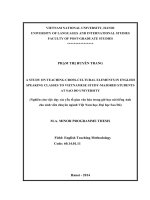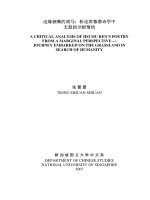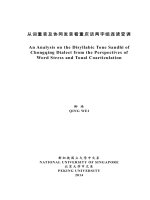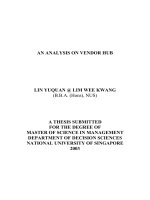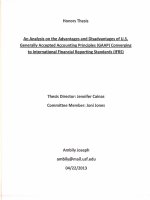An analysis on cultural elements in translation of English slogans into Vietnamese
Bạn đang xem bản rút gọn của tài liệu. Xem và tải ngay bản đầy đủ của tài liệu tại đây (607.55 KB, 43 trang )
ACKNOWLEGEMENT
On the completion of this graduation paper, I wish to express my
special thanks to many of my teacher, my family and friends from whom I
have received a great deal of assistance, guidance and encouragement.
First of all, I would like to express my gratitude to my supervisor Nguyen Thi Phi Nga, M.A. for her constant support, various materials,
precious advice and valuable comments on draft chapters to complete
this study.
I would like to extend my sincere thanks to all the teachers in
Foreign Language Department for their useful lessons during four years
studying.
Last but far from the least, my thanks are presented to my family
and all of my friends for their encouragement, inspiration in the process
of completing this paper.
Haiphong, June 2009
Nguyen Thi Hoai
HAIPHONG PRIVATE UNIVERSITY
DEPARTMENT OF FOREIGN LANGUAGES
GRADUATION PAPER
AN ANALYSIS
ON CULTURAL ELEMENTS IN
TRANSLATION
OF ENGLISH SLOGANS INTO
VIETNAMESE
By:
NGUYỄN THỊ HOÀI
Class:
NA901
Supervisor: NGUYỄN THỊ PHI NGA, M.A.
HAI PHONG – JUNE 2009
TABLE OF CONTENTS
PART I: INTRODUCTION
1. Rationale …………………………………………………………………. 1
2. Research Method …………………………………………………………. 1
3. Research Restriction and Application ……………………………………. 2
PART II: DEVELOPMENT ……………………………………………… 3
Chapter 1: Theoretical background………………………………………. 3
1.1. Language of slogans …………………………………………………3
1.1.1. What is a slogan? ………………………………………………….. 3
1.1.2. Functions of slogan ………………………………………………... 3
1.1.3. Features of slogan………………………………………………….. 4
1.2. Translation ………………………………………………………….. 4
1.2.1. What is translation? …………………………………………………4
1.2.2. Types of translation …………………………………………………6
1.2.2.1. Word- for - Word Translation ……………………………...6
1.2.2.2. Literal Translation ………………………………………… 7
1.2.2.3. Faithful Translation ……………………………………….. 7
1.2.2.4. Semantic Translation ……………………………………….7
1.2.2.5. Free Translation.……………………………………………8
1.2.2.6. Idiomatic Translation……………………………………… 8
1.2.2.7. Communicative Translation ………………………………..9
1.2.2.8. Adaptation …………………………………………………9
1.3. Culture……………………………………………………………....11
1.3.1. What is culture? …………………………………………………...11
1.3.2. Aspects of culture…………………………………………………. 11
1.3.2.1. Historical Aspect………………………………………….12
1.3.2.2. Geographical and Psychological Aspect …………………12
1.3.2.3. Material Aspect…………………………………………...13
1.3.2.4. The Customs and Traditions Aspect ……………………..14
1.3.2.5. The religious culture ……………………………………..16
1.3.3. Western Culture and Eastern Culture………………………………16
Chapter II: Translation of English- Vietnamese Slogans……………….19
2.1. Commercial Slogans…………………………………………………..19
2.2. Educational Slogans…………………………………………………..25
2.3. Social Slogans………………………………………………………….27
Chapter III: Suggested translation of slogans under the views of culture..29
3.1. Some successful translation of slogans ………………………………29
3.2. Some suggestions for translation of English slogans in the light of culture
……………………………………………………………………….. 32
PART 3: CONCLUSION …………………………………………………36
Reference …………………………………………………………………...37
Appendix
PART ONE: INTRODUCTION
1. Rationale
Language is the most essential means of communication of human being.
Man, so far, has made a lot of afford to decode and encode one another’s
ideas and messages; however, it is much trouble if we want to express our
thought in any second language. There are many languages which extinct or
disappear with time. Besides, every language origin is based on each nation’s
culture, which makes language more and more plentiful and various.
As we know, English is now considered an international language and used in
most nations, as well as in Vietnam. However, there are difficulties in
English – Vietnamese translation because of differences in structures and
cultures. Moreover, now together with international communication and
integration, more and more English slogans are used. Of course, between a
foreign language and a native language, there are some problems in
translation in general and in translating English slogans in particular. In daily
life, I often meet a lot of slogans in many fields and I do not know how to
translate it correctly. I am an English major student, sometimes I feel difficult
to translate English slogans into Vietnamese. Hence, I see that there are many
interesting things on translating English slogans into Vietnamese, which
makes me curious and I like it so much. That is the main reason I choose this
graduation paper for my researcher.
2. Research Method
To achieve of aims of the study successfully and effectively in my studying
process, I store knowledge from a lot different kinds of resources specialized
as following:
Library and Internet search.
Collection of English and Vietnamese slogans.
Lectures and Experts’ consultation.
3. Research Restriction and Application
Translation is extremely large of study including methods in translation.
However, due to the limitation of time, knowledge, and experience, I am not
ambitious to study all matters about translation. Therefore, I only focus on
translating English slogan into Vietnamese in this research paper.
Particularly, I pay much attention to the cultural in translating English slogan
into Vietnamese.
My study is completed in the ambition of giving further studying about
method of slogan translation.
While carrying this studying, I hope to acquire useful experiences in learning
and translating English.
Moreover, this study help students who are interested in the culture in
translating know more about it.
PART TWO: DEVELOPMENT
CHAPTER 1
THEORETICAL BACKGROUND
1.1.
Language of slogans
1.1.1. What is a slogan?
A slogan is a memorable motto or phrase used in a political, commercial,
religious and other context as a repetitive expression of an idea or purpose.
A slogan is the verbal or written portion of an advertising message that
summarizes the main idea in a few memorable words--a tag line.
( />A slogan is a phrase that visually conveys the most important product
attribute or benefit that the advertiser wishes to convey.
A slogan is a catch phrase or small group of words that are combined in a
special way to identify a product or company or organization.
1.1.2. Functions of slogan
The purpose of a slogan is to communicate some information about the
product or a program and fix it in the readers mind in a memorable way. So
that, there are 5 functions of a slogan to show these purpose:
Drawing customer’s attention and arousing his interest
Encouraging a reader into further reading of the text
Conveying an advertising message in the shortest possible form
Evoking in consumer’s mind a desire of possessing a given product
Summarising and summing up the whole text as well as making the
receiver remember the advertisement or the program.
1.1.3. Features of slogan
A slogan sums up what one stand for, one’s specialty, the benefit, and one’s
marketing position, and one’s commitment. It is especially useful to reinforce
one’s identity. So that some following features show how slogan can show its
aims:
The slogan is just like a headline that uses initial capitalization to
attract more attention or to stress every word it says to impress the reader.
The slogan needs to emphasize every letter it uses or to make the
slogan look trim and tidy.
The slogan usually uses rhymes and alliteration. Alliteration can help
the slogans achieve the strong beating rhythm needed to make it as repeatable
sentence. By so doing, the sentences are more slogan-styled. They can be
easily remembered by the audience.
The slogan must be short and simple; it cannot afford to be
complicated and clumsy. Short simple sentences are easy to remember, while
one main aim of a slogan is to be memorable and recited.
Beside that, the slogan often uses imperative sentences or questions
especially everyday sentences and creates idioms or proverbs.
In addition, almost all the ad slogans use simple present tense.
1.2.
Translation
1.2.1. What is translation?
Translation is an operation performed on language. It is an across the board
skill which helps improve student’s language proficiently in the process of
translation, a text in another. Thus, it is the important means of
communication between people is different language. Since then, it can
attract the attention of many to linguistics researchers and translation
theorists, so what is translation? There are many definitions around this.
According to Nida and Baber: “ Translation consists of reproducing in the
target language the closet natural equivalent of the source language message,
first in terms of meaning and secondly in term of styles.
( Nida and Baker, 1974: p 12).
Translation is a kind of activity, which inevitably involves at least two
languages and two cultural traditions.
(Toury, 1978: p.200).
Translation is a process based on the theory that is possible to abstract the
meaning of a text from its forms and procedure that meaning with the
different forms of a second language.
Translation is the general term referring to the transfer of thoughts and ideas
from one language (source) to another (target), whether the languages are in
written or oral form; whether the languages have established orthographies or
do not have such standardization of whether one or both languages is based
on signs, as with sign languages of the deaf
(Brislin, 1976)
Translation is the action of explanation of the meaning of a text, and
subsequent production of an equivalent text called a translation, that
communicates the same message in another language. The translated text is
called the source text, and the language it is to be translated into is called the
target language; the final product is sometimes called the target text.
( />Duff also cited a definition of translation as follows: “Translation, as the
process of conveying messages across the linguistic and cultural barriers, is
an eminently communicative activity, one whose use could be well
considered in a wider range of teaching situations than may currently be the
case”
(Tudor, citied in Duff , 1989: p.5)
Different author give definition of translation: “Translation is a craft
consisting in the attempt to replace a written message and/ or statement in
one language by the same message and/ or statement in another language.”
(Newmark, 1982: p7)
1.2.2. Types of translation
For learners of English, there are different approaches to translation. For a
number of definitions of translation give above, we can see that
understanding toward translation varies from one to another. As the results of
such diversity, translation can be classified into different viewpoints. The
followings are the commonly used translation types:
1.2.2.1. Word – for – Word translation
This is the type of translation that learners of English are likely to take up in
the process of mastering their translation skills. In word-for-word translation,
the source language word order is preserved and the words translated singly
by their most common meanings, out of context.
In word-for-word translation, the result often makes little sense, especially
when idioms are involved. The translator can use word-for-word translation
both to understand the mechanism of the source language and to construct a
rough translation process for a difficult text.
Example: All worldly things may change with time, but the impression of
the first love will remain a vivid as ever.
(Victor Hugo)
Tất cả mọi vật trên thế gian có thể thay đổi với thời gian, nhưng ấn tượng
về mối tình đầu sẽ tồn tại mãi mãi.
(Vương Trung Hiếu, 1993: p.147)
1.2.2.2. Literal translation
Literal translation is a broader form of translation, each source language word
has a corresponding target language word, but their primary meanings may
differ. Literal translations follow very closely the grammatical and lexical
forms of the source text language.
Literal translation is considered as the basic translation step, both in
communicative and semantic translation.
Example: I tried for a moment to see the situation through her eyes.
(Deignan, 1998: p.6)
Tôi đã thử một lần cố nhìn nhận tình huống theo cách nhìn của cô ta.
1.2.2.3. Faithful translation
A faithful translation requires a faithful precision in meaning and grammar
structure of the original. However, we can also transmit the source language
text into the target language one more flexibly basing on its contextual
meaning.
Example: Fed is trying to lose a few pounds. He goes jogging for an
hour every evening but when he comes home, he eats like a horse.
(Seidl & McMovdie, 1988: p. 239)
Fed đang cố gắng giảm vài pound. Mỗi đêm anh ta chạy bộ khoảng một tiếng
nhưng khi về nhà anh ta ăn như trâu.
1.2.2.4. Semantic translation
Newmark (1982) states that: “… semantic translating where the translator
attempts, within the base syntactic and semantic constraints of the target
language, to reproduce the precise contextual meaning of the author”.
Therefore, the semantic translation is more flexible than faithful translation,
admits the creative exception and allows the translator’s intuitive concession
with the original.
Example: Beauty is the first present Nature gives to women and the
first take away.
Sắc đẹp là tặng phẩm mà Tạo hóa ban cho người đàn bà, cũng là thứ đầu tiên
mà Tạo hóa cướp đi.
1.2.2.5. Free translation
In free translation, the linguistic structure of the source language is ignored,
and equivalence is found based upon the meaning it conveys. Free
translations are sometimes called paraphrases. The advantage of this type of
disadvantage is that translating is too casual to understand the original
because of its freedom.
(Dung Vu, 2004, )
Example: … người ta thường trích trong di sản một phần tài gọi là
đất hương hỏa hoặc ruộng kỉ giao cho người tộc trưởng hoặc người chi
trưởng để lo thờ tự tổ tiên ở nhà thờ họ hoặc nhà thờ chi.
…. People often deduct from the inheritance of a part of estate which call
“cultural estate” or “anniversary land”. The land is entrance upon the head of
the extended family or the head of the branch of the family. The latter keeps
it in order to care for the ancestor cult, performed in the cult home of the
extended family and in that of the family branch.
(Võ Liêm An, 1997: p.237)
1.2.2.6. Idiomatic translation
Idiomatic translations are concerned with communicating the meaning of the
source text using the natural grammatical and lexical items of the target
language.
Idiomatic translations are used for colloquialism and idioms whose literalism
is the translation by which the translator does not transfer the literalism of the
original, uses the translation of colloquialism and idioms.
Example:
A sow is no match for a goose.
Đũa mốc mà chòi mâm son.
1.2.2.7. Communicative translation
Communicative translation allows the translator to transmit the source
language into the target language by readily acceptable and comprehensible
ways to the readership. “But even here the translator still has to respect and
work on the form of the source language text as the only material basic for
his work”
(Peter Newmark, 1982: p39).
Example:
Thôi thì hết hờn ghen và giận dỗi
Được giận hờn sung sướng biết bao nhiêu.
(Xuân Diệu)
Well, it’s all with jealousies and sulks
What fun to be in the sulk.
(Vương Trung Hiếu, 1993: p.145)
1.2.2.8. Adaptation
Dung Vu (2004) point out: “Adaptation has a property of lending the ideas of
the original to create a new text used by a new language more than to be
faithful to the original. The creation in adaptation is completely objective in
content as well as form”. So, adaptation is the freest form of translation. It
issued mainly for plays and poetry …
Example: Someone you pass on the street may already be the love of your
life
.Có khi nào trên đường đời tấp lập
Ta vô tình đi vội bước qua nhau.
(Từ Huy)
Source language emphasis
Target language emphasis
Adaptation
Faithful translation
Semantic translation
Communicative translation
Word-for-word translation
Literal translation
Idiomatic translation
Free translation
1.3. Culture
1.3.1. What is culture?
Culture consists of patterns, explicit and implicit, of and for behavior
acquired
and
transmitted
by
symbols,
constituting
the
distinctive
achievements of human groups, including their embodiments in artifacts; the
essential core of culture consists of traditional ideas and especially their
attached values; culture system may, on the other hand, be considered as
products of action, and on the other as conditioning elements of further
action.
(Kroeber, AL, & Kluckhohn, C. 1945 p.78-105)
Culture is the shared knowledge and schemes created by a set of people for
perceiving, interpreting, expressing, and responding to the social realities
around them.
(Lederach, J.P. 1995 p.9)
A culture is a configuration of learned behaviors and results of behavior
whose component elements are shared and transmitted by the member of
particular society.
(Linton, R. 1945 p.32)
A culture is a way of life of a group of people--the behaviors, beliefs, values,
and symbols that they accept, generally without thinking about them, and that
are passed along by communication and imitation from one generation to the
next.
( />1.3.2. Aspects of Culture
In accordance with the definitions of culture, it is clear that culture is
composed of many elements. It is very conducive to look at the elements of
culture as a way of studying culture and translation. In fact, culture is divided
into the following five aspects, interacting with each other: historical culture,
geographical and psychological culture, material culture, customs and
traditions as well as religious culture.
1.3.2.1. Historical Aspect
The historical culture refers to the culture settled and formed during the
development of society. Different nations have different historical
development, so their historical cultures are different. This kind of difference
impedes the communication between languages. For instance , the
Vietnamese allusion “con Lạc cháu Rồng ”must be translated in a direct way
with some explanations, for there are lack of such historical background in
western countries. One English version is: “Lac Rong offsprings”
Let’s see another example. During the historical development of English
language, the introduce of the Bible and the mythology of ancient Greek and
Rome brings about many cultural words, such as “Adam’s apple” “Good
Friday” and “Achille’s heel” etc. These words, with their special historical
and cultural meanings in English language, can’t be translated into
Vietnamese just by their literal meanings. For example, the direct translation
of “Adam’s apple” is “quả táo của Adam”. However, this term is originated
from the story of the Bible. It is said that one day, God discovered that Adam
and Eva, the ancestors of our human beings, ate the forbidden fruit, so he
gave punishment on Adam by letting the fruit blocking in his throat.
Therefore “Adam’s apple” refers to the lump on the front of throat in the
western culture.
1.3.2.2. Geographical and Psychological Aspect
Different nations’ geographical and psychological culture is also a main
barrier in translation. Because of the different geographical environment and
different nation’s mentalities, the same word will have totally different
meanings in two different cultures. For instance, words like “fire, sea,
Roland, Oliver, castle, shepherd, nightingale” cause a different mental
responding among Vietnamese readers while words like “giang sơn, núi non,
biển cả, rừng vàng, biển bạc” in Vietnamese have their particular imaginary
meanings, but they could not be experienced and felt by the western readers.
For example, “East wind” in Vietnamese and English is a vivid example.
Vietnamese people favors the east wind, for it is always a symbol of “spring”
and “warmness” while people in Britain dislike the east wind, because the
east wind is from the northern part of the European continent, so it always
symbolizes “coldness” and “sadness”. In Britain the favorite wind is the west
wind, so when we translate Shelly’s “ode to the west wind”, we’d better add
this geographical reason.
Also meanings of some “places” are different. In English, “Sanfransico” is
always connected with “deep sea” and “Washington” is with “steep mountain
edges”, so such expression “between Washington and Sanfransico” can not be
translated into Vietnamese with names of these places, we should translate
into “tiến thoái lưỡng nan” instead.
1.3.2.3. The Material Aspect
The material aspect of culture refers to the material achievements of a social
group. The following elements of culture belong to this aspect: economy,
science, technology, food, clothing, shelter, transportation, tools and other
artifacts that characterize a group of people.
Success in translating information or messages about artifacts or other
distinctive material achievements of a people will contribute much to the
intercourse in this respect and will enable other people in the world to share
the material achievements, which will bring about faster development of
material culture.
Many words reflecting the distinctive material culture in the source language
should be paid much attention to when translated them. For example, the
word “cricket” is a peculiar word in the English language, for it is a popular
outdoor game in Britain, and plays an important role in people’s daily life.
There is a saying “It is as significant as a game of cricket.” If we want to
translate this sentence, we should add some background information for the
Vietnamese readers, because playing cricket is rare in Vietnam.
Another example is the term of colors, “green” and “blue”. To our
Vietnamese readers, we may feel confused about its meaning and only
translate it into “xanh lá cây” and “xanh nước biển”. While according to its
cultural background, this term simply means the “envious/jealous” and “sad”,
because “green eyes” is a euphemism for the “very jealous person” and “in a
blue mood” in Western countries. By using this term, addressees may not feel
hurt.
A certain kind of cultural phenomenon in Vietnam may greatly differ from
that in Britain. Let’s see the following quotation:
“Bright red costumes, with hats, shoes and stockings to match, are to be all
craze in the spring. Smart women will have to be careful not to yawn in the
streets in case some short-sighted person is on his way to post a letter.”
The color of the post box in Britain is red hence the author makes fun of
those fat ladies in red, who are just like post boxes. But this phenomenon
does not exist in Vietnam where the color of the post box is green, so the
color “red” will become an untranslatable factor.
Or in term of food, some traditional Vietnamese food can not translated
directly as “Chung cake”, “Day cake” because “bánh Chưng”, “bánh Dày”
referred to Vietnamese philosophical legend, and Vietnamese people only eat
these food on these special occasion with their wishes of prosperousy, health,
happiness and family reunion while “cake” is just a daily food to English
people tasting sweet for a tea break. Or “bánh nướng, bánh dẻo” is translated
into English “Moon cake”, named after the Moon Full Festival in August
when “bánh nướng, bánh dẻo” is offered.
1.3.2.4. The Customs and Traditions Aspect
The communicative system, verbal and non-verbal, distinguishes one group
from another. This aspect of culture includes verbal language and non-verbal
behavior (body language). Through translation, people speaking different
languages can communicate with each other and exchange their opinions.
Translation will also accelerate the exchange of different non-verbal
behavior, thus making different communication systems known to each other.
The different customs and traditions in the daily activities and
communications in Vietnam and Western countries reflect the different
cultural mentality. The naming system is a good example, which reflects the
different standards of the degrees of people’s close relations, the relations
between people in the higher and lower levels. In Vietnam, people used to
call others by their titles, professions to show the respect while in western
countries people call each other’s name directly to show the close relations.
In Vietnamese, especially in the written language or in the formal situations,
people like to call themselves by some modest words; and call others by
some honorable words such as “cụ, ông, bà, cô, chú, bác, anh, chị, thím, mợ,
dì …”. In translation, we always tolerate the vacancy of these modest words
in English, complying with the rules of the English language. Another
example is the different expressions in greeting, naming, appreciating,
praising, apologizing, departing and making telephone calls. In Vietnam,
when we meet each other in the street, we always greet like this “where are
you going” or “what are you doing”. In fact, this kind of greetings is very
rude and impolite in western countries, for it is an interference of privacy.
Instead we’d better translate them into “hello” “good morning” or “how are
you”.
Human behavioral systems and their products-social institutions are called
the institutional aspect of culture. It includes political and economic
activities, law, manners, customs and habits, economic system, political
system, educational system, religious system, kinship system and technical
system. Translation can be very helpful in our understanding different
behavioral systems and social institutions and drawing on their strong points.
1.3.2.5. The religious Aspect
This aspect, or perceptional aspect of culture, includes religions, beliefs,
worldview, ways of thinking, systems of values, national spirit and national
disposition.
Religious culture means the culture formed by a nation’s religious beliefs and
common sense. Its difference lies in the difference in the beliefs and the
prohibitions of different countries. If we want to translate the sentence “ở
hiền, gặp lành”, we can not translate it into “stay gently, meet evenly.”
Though it is proper in both meanings and patterns, it is a belief, which is the
Buddhism rather than the Christianity. So it should be translated “One good
turn deserves another”. The Vietnamese people have their own belief
expressing in the old saying “ Ta về ta tắm ao ta, dù trong dù đục ao nhà vẫn
hơn”, so when translated into English, it should be closed to Western belief “
East or West, home is best”
People learn to think, feel, believe and strive for what their culture considers
proper. Thus, the conceptual aspect of culture is the deepest structure and the
focus of culture. It is this aspect of culture that makes a person distinct and
renders translation much more difficult.
The above five aspects of culture are different parts of a whole and they
interact with each other. Success in translation is, to a great extent, success in
translating these aspects or transferring these cultural messages.
1.3.3. Western Culture and Eastern Culture
In the world, there are two kinds of cultures, which create different easternwestern culture; however, each nation keeps oneself private character about
geography, historical, material, customs and habit … It means that its
language reflects culture of a nation, especially by vocabulary. Vietnam with
complex terrain, long-standing agriculture, and long magnanimous fight
against invaders and in monsoon tropical region, which is considered as main
character of Vietnam, reflected in names, means of productions, rice
processing, customs and habits about marriage, customs and habits about
religion.
All things are very popular in Vietnam; however, these things are very
strange for Western people. To Western culture, their life is very active, free
to accept new things, such as science, internet,…in the life. Beside, English is
rye agriculture, which is different from Vietnam agriculture. Their work is
more developing with advance machines. Hence, their character is individual.
Contrary to, Vietnamese one is combinative each other.
For a long time, Western culture and Eastern one have been having
differences. Some following pictures show those differences. Let us discover
these interesting things.
Opinion
Way of Life
On time
Communication
Party
Notes: Western people in blue, Eastern people in red.
CHAPTER II
TRANSLATION OF ENGLISH- VIETNAMESE SLOGANS
In modern age, we find ourselves surrounded by various slogans every day.
We find slogans of all kinds everywhere, for example, glittering neon signs
on top of high buildings and along main streets, colorful pictures painted on
buses, pamphlets sent to every house, advertisements jammed between TV
programs, various slogans glutting newspaper and radio broadcast, etc . . . So,
why slogans can popular that? The reason is a slogan can sum up what one
stand for, one’s specialty, the benefit, and one’s marketing position, and one’s
commitment. It is especially useful to reinforce one’s identity.
2.1. Commercial Slogans
We all know that commercial is a kind of public communication, and
commercial has become a dispensable tool in business. A company becomes
truly global not only through moving its headquarters to other countries, but
also via branding strategies and marketing messages. Commercial is getting a
signification used to direct persuasive communication to potential consumers
and
target
public.
Therefore,
commercial
advertiser
must
create
advertisements to strike a deep impression on consumers not only the image
but also the language. You know the marketing massage (the slogan) is
considered as the soul of commercials. When a product enters any market
their brand name and slogan is translated into the target market. There are
many foreign companies have success in Vietnam market thank to translating
slogan successfully.
Example 1: NOKIA
As we know, Nokia is a brand name of a famous cell phone company and it is
considered as the pioneer in this field in Vietnam. The cell phone in Vietnam
is developing quickly with many of kinds but Nokia is the most popular brand
name. It explains the reason why everywhere we can find a slogan of it easily.
So that everybody knows this product very clearly.
“Connecting People” “Kết nối mọi người”
Example 2:
Kentucky Fried Chicken is the product of American with slogan:
“Finger licking good!”
“Vị ngon trên từng ngón tay”
Everybody who watched the “Meeting at New Year’s Eve 2009”
program on VTV3 channel of Vietnam Television must remember the
performance of “Economy Apple”. He referred to a brand name of fast food it
is KFC. It originated from America and spread out over the world. It enters
Vietnam market and become a favorite food of the youth. Its slogan is said
daily by the youth and children.
Example 3: Tiger Beer
“Asian Man Spirit”
“Tiger bia - Bản lĩnh đàn ông”
We can see that nowadays beer is very popular with increasing of living
standard. Anyplace we can meet the trade name of beer, along the street or on
the wall. One of the famous trade name beers is Tiger beer which is wellknown over the world. Its brand name is a tiger that is called the dominator of
jungle. Almost the men like this beer may be not only by the quality but also
by its brand name and slogan.
Example 4: />

